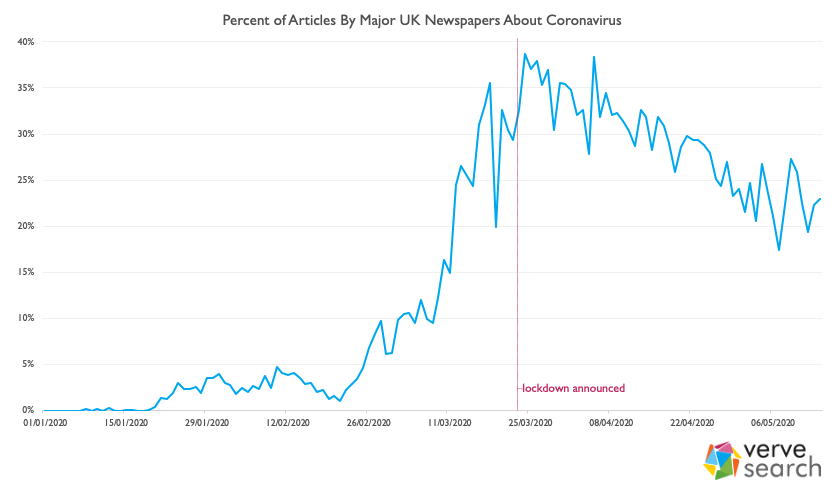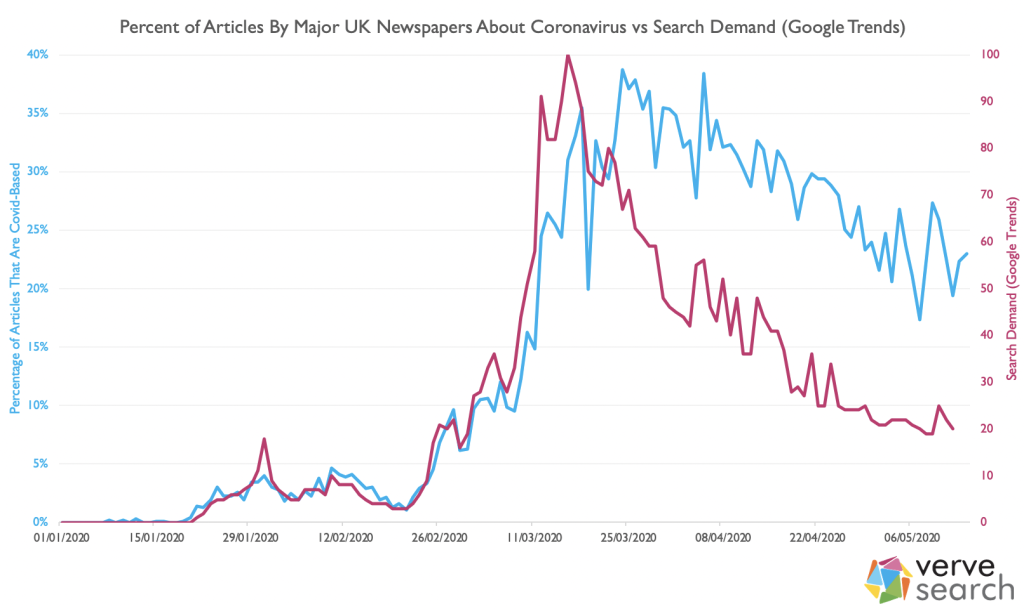It might not feel like it, but coverage of coronavirus in the UK is reducing and has been reducing for over a month. With less than a quarter of all stories now being COVID focussed (down from a high of nearly 40%), journalists are desperate for positive, feel-good news. We took a look at what that means for outreach in exceptional times.
Our data
At the start of March, we heard from a lot of companies concerned that there was no room for brands in newspapers clamouring to cover the coronavirus. We were asked, frequently, whether it made sense to just stop outreaching entirely rather than trying to cut through the noise.
For the last 9 or so months, we’ve had a project underway where we’ve been scraping the major newspapers around the world. This data, now including over a million articles, provides us with unique insight into quite what’s being written about.
We decided to mine the data to see how many articles are being written about COVID. For this exercise, we defined an article as being about COVID if it mentioned ‘COVID’, ‘coronavirus’, ‘pandemic’, ‘furlough’, ‘quarantine’ or ‘lockdown’ in its title. This was to avoid including any articles that mentioned coronavirus but weren’t about coronavirus. We also limited this particular analysis to UK newspapers; I’m sure there’s a great piece of analysis to be done on how much coronavirus is being discussed in different countries, but that’s for another post.
What we found
Coronavirus stories were a very small part of the media landscape early this year. It wasn’t until 25th February that COVID stories made up more than 5% of the news cycle. It would take 3 days for this figure to double and less than two weeks more for it to double again to just over 20%. Just after the lockdown was implemented, on the 24th March, coverage of coronavirus in the UK peaked, with 39% of all articles being COVID focussed. That has been dropping, relatively consistently, ever since. Last Thursday, as the nation prepared itself for a long weekend and VE day celebrations, coronavirus stories dipped to just 17%; the lowest it had been since early March.
Whilst 39% is undoubtedly a lot – thousands of articles each week on a single subject – it’s probably much less than you’d think if I’d asked you to guess. As you’ll have found out if you’re currently outreaching though, whilst coronavirus stole the frontpages and the headlines the newspaper industry has still been pushing out stories. Even at its highest, the majority of stories were not about coronavirus – and we’re now far from that peak.
Journalists’ stories follow public interest. This has never been more true than with coronavirus. If we look at UK Google trends data, we see both search volume and articles practically in lock-step with each other; articles following the previous couple of days search-demand:
At Verve, we use LinkScore to value the links that we build in a way that’s consistent, objective and takes into account a whole plethora of key factors (relevance, site authority, no-follow status, whether it’s syndicated etc), which allows us to easily compare our outreach output year on year. When we did, we saw a picture that mirrors the above up until this last month:
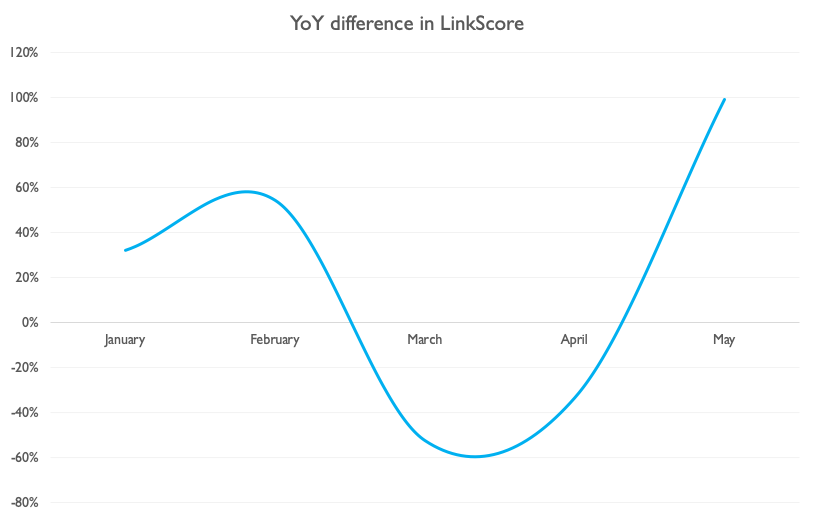
Considering that, since February, we’ve had some clients on hold and some of the team is furloughed, May’s data represents more than a return to the previous form. Even with the reduction in coronavirus stories, there’s more going on. So, you might wonder, why are we seeing such results recently?
What’s Working?
1. Keeping a positive mental attitude
Lisa’s talked previously about how a lot of outreach success can be attributed to attitude and grit. Finding yourself unexpectedly working from home, with strict government measures imposed and every newspaper headline seemingly dedicated to coronavirus can knock your confidence. Here are a few ways to keep it high:
(a) Share your wins
As a result, sharing wins (something we were already doing) became even more important. We have a Slack channel, we call Linkbell, dedicated to new links as they go live:
 We also share, across a couple of other channels, TV, radio and print coverage:
We also share, across a couple of other channels, TV, radio and print coverage:
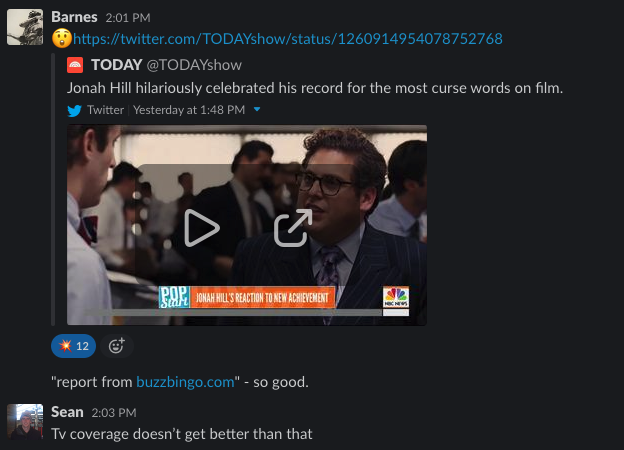
(b) Realise there’s now less competition
According to ONS figures, 27% of the UK workforce has now been furloughed. If we assume that the figures as roughly equal for the PR and SEO sectors, this would have a substantial effect on the level of competition when emailing journalists…so we decided to look at two different metrics to estimate the effect of furloughing on these industries:
1. Back at the end of April, PR Week reported that 35% of PR firms reported having furlough around a quarter of their team, with a further 25% having furloughed some, but less than 25% of their team. If we assume an even distribution on that 25%, we can estimate that, in total, around 12% of the PR workforce in the UK is currently furloughed.
2. We investigated this by looking at the number of press releases that had been published on PRNewswire this year. Now, we know that news wires are decidedly old-hat, but that was as true in January as it is now, so any change in the last few months can be considered meaningful.
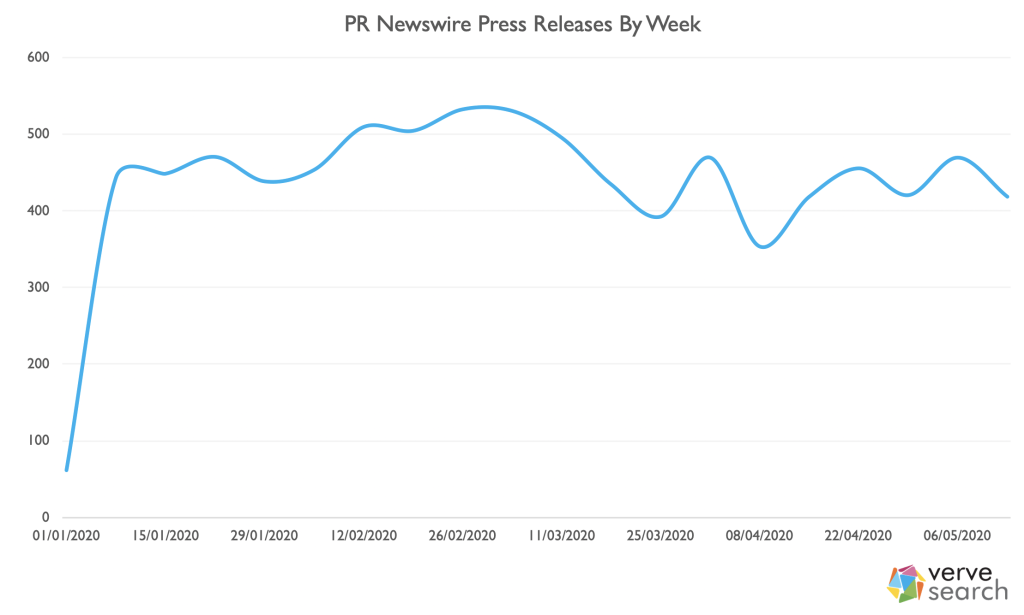
If we assume that the rate of press releases being published would have continued at the rate it was at in late February, press releases are down 21%.
Based on these two measures, journalists should currently be receiving 12%-21% fewer pitches; that’s less noise to cut through and that makes it ‘easier’ to achieve coverage.
Take the time to also Google the brand names of your competitors. It’s possible they chose to pause their link building and, if they did, know that each link you build is either extending your lead or working towards catching them up.
(c) Stay connected
One of the things a lot of us love about SEO is the community so, now, more than ever, it’s important to be a part of it. I find value in the BigSEO Slack group and can often be found lurking in the outREACH Community Slack. Meanwhile, there are virtual conferences galore; not least SMX Next and outREACH Online.
2. Positive news
Lots has been written on this, not least by Verve’s own Sean, but when the news turns bleak people seek out the uplifting and irreverent. That’s partly why we’ve seen stories about:
- A pensioner pacing his garden – and raising £33 million in doing so.
- Chance the Rapper handing out an award to a rapping teacher.
- The balcony concerts in Italy
Those didn’t just sneak under the radar; journalists have been actively calling out for positive news:
OK Yorkshire, here’s my challenge. I want as much non-coronavirus-related news as I can find. PR teams, big opportunity here for you to showcase interesting and genuine activity with your clients. Our readers don’t just want to read Covid-19 stuff. Now is your chance to shine.
– Mark Casci (@MarkCasci) March 23, 2020
Looking for original travel feature ideas – not just UK-focused. Need inspiring, bucketlist, planning for future, retrospective and funny feature ideas. Have budget. Help! #journorequest
– Lisa Minot (@lisaminot) April 6, 2020
Hello #PR friends! We can’t write a whole paper about Coronavirus. We don’t want to. We need your non-CV themed stories more than ever. Fun stuff especially. Email in my bio! #journorequest
– Felicity Cross (@fliccross) March 17, 2020
3. Sector by Sector Results
It’s no surprise to say that if you are in a position to talk authoritatively about coronavirus then there’s a lot of link opportunities. There are more subtle opportunities though. That’s because several industries just don’t have much going on because of social distancing. Film, sport and travel journalists, for example, have all had the big events that typically punctuate their calendars either cancelled or paired down. Whilst this also means that some campaigns, and headlines, just don’t make sense at the moment (e.g. cheap holiday deals in travel) a great headline could do better than ever.
There are also opportunities to craft content and campaigns around areas that people are searching for more of because of being stuck at home including:
| Topic | YoY Change |
| Working from home | +614% |
| Online lessons | +378% |
| Virtual tour | +342% |
| Cocktail recipes | +321% |
| Pogo stick | +209% |
| Classic movies | +208% |
| Baking | +190% |
| Adoption | +138% |
| DIY | +87% |
We’ve seen this in action with a few different movie-themed campaigns, but we’re also seeing gains on nostalgic content (as ‘classic movies’ implies). You can read about one of those campaigns here.
In Summary
Consumer behaviour is changing, and journalists are changing their coverage with it. With articles on coronavirus reducing every day and many companies yet to return their marketing teams from furlough, we’re now seeing over-sized returns from link building again. If you can put together a headline that touches people and creates discussion you’ll find high relevancy, high authority links follow.


